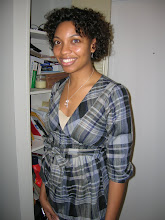I will be dealing with discrimination within the African-American culture through colorism. Some may not be familiar with the word, but it deals with discrimination within a particular culture or race of people because of skin tones. It's a subject that hits me quite personally, and I'm sure that there are many other people of color who have experienced the same. The goal is to look at the African-American culture more specifically because it's what I personally know, but the bigger picture is to question what colorism does to culture. It is also important to address how discrimination still raises its ugly head in many ways. I'm really excited about this project and how found its been very life changing for me already.
As a african-american woman I've found myself caught between the fire of colorism since a young girl. To address these hidden issues have not only been healing for me, but very mind provoking. I am aware that people "perish" for lack of knowledge. I soon became aware that by not addressing affects of colorism in my own life that I wasn't truly allowing myself to be me. To tell a story that relates to me but is not about me. So this semester will highlight this heavy research. I don't see it as a self-expression piece. I realize that there are many people within my culture that can identify with what I want to say, and I think its wise to communicate something that is understandable to me as well as others.
It was suggested that I take a class on African- American artist history this semester, which by the way is a miracle!! I have to be honest in saying that I'm impressed with AIB for its inclusion of cultural arts. There really are not many classes with that title, at least in my experience at art schools. A friend and I almost protested this issue at our art school in Texas, but both found ourselves studying in Europe. Which ironically many black artists evidently did according to my african american artist class . How scary!!! I knew that I felt more comfortable studying in Europe (mostly because I didn't have to answer questions about why my subject was a black person) but I didn't realize how many other artists in history had experienced this same abuse in similar ways. Nevertheless, it has been by far the most captivating art history class I've ever had. There are mainly many artists that I have never heard of (at this point) that look and speak (visually and artistically) very similiarly to me. I was almost mad that this type of course is only offered every 2 years. But then I looked around the classroom and noticed that many of the other students weren't as interested in the subject as much as I was. Perhaps because I find it liberating to see work produced by people within my own culture( which doesn't happen very often), and to others it just didn't relate. That could be another essay all by itself. But in other words, I have discovered more layers that certainly can be addressed. Honestly, I'm excited to be talking about it.




2 comments:
Hi Lauren, it looks like you are off to an excellent start. I am glad that you have found this course and subject matter that touches you deeply. I believe that you will have so much to create using your voice for yourself and others!
Congratulations on selecting another great project. I encourage you to read the book "Cane River" by Lalita Tademy. It's on the Oprah's book club list and was a best seller a few years back. Below is just a few comments from her interview with Oprah regarding colorism and you'll see why I think her book will be an excellent resource: The Hierarchy of Light Skin/Dark Skin
Oprah: When I announced the book, I said specially that it's about lots of different things, including the whole miscegenation and the light skin/dark skin [which] runs deeper than I think any of us consciously are aware of on a regular basis. Did you know that you were uncovering all of that?
Lalita: I knew that it resonated. I didn't know it was going to resonate. I've been getting a lot of feedback on that specifically. And it surprised even me how deep it was. People said that this explained to them for the first time what some of the origins of that might be. And it brought them a little closer to, if not forgiveness, at least understanding.
Oprah: Understanding that ... people felt safer, more protected, and that your life would be better based upon the lightness of your skin.
Lalita: And the possibility of more opportunity.
I look forward to seeing the end results of this project.
Post a Comment